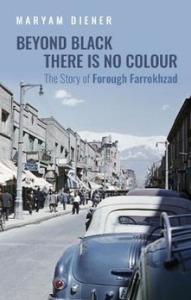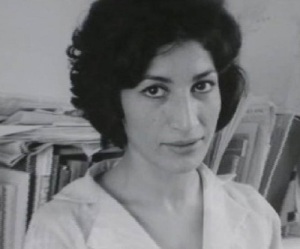I’m often on the lookout for the little known female voices outside the mainstream, some will be in translation, titles and authors I haven’t heard of, women who have lived a different experience, shared their insights, who might have left earlier lives behind, who illuminate stories that deserve sharing.
Down the Rabbit Hole of Books We Burrow

And so I stumbled across the Iranian writer Maryam Sachs, whose book Without Saying Goodbye (2009) had been translated into English from French Sans te dire adieu, about an Iranian exile living in Paris working in a bookshop.
I then learned her name had changed to Maryam Diener and she had written a book about the iconic feminist Iranian poet and film maker Forough Farrokhzad, Beyond Black There is No Colour (2020).
So here is one writer who left an earlier life, writing about another who was pushed from hers, but who enabled through her poetry and film, other Iranian women to dare to express their own sincere thoughts and words.
Diener reimagines the life of the young revolutionary poet in this heart-felt novella, portraying a young woman who desired to be authentic and write from the core of her being about her emotional life and loves and losses, in a way that no woman before her had ever dared.
She sought expression for her depth of feeling, wanted to talk about it with others, and would also follow that same passionate way of being in the world into film making, casting aside more structured plans, to again follow her heart and allow others to have voice through her work.
Forough Farrokhzad, The Rebel Poet of Iran
 Farrokhzad (1935-1967) published poems that radiated sensuality, plunging depths of emotion, challenging the patriarchal conventions of society and transcending the acceptable boundaries of women’s expression, let alone commit to paper and public record. She wrote of love without shame, removing the invisible but ever present mask the culture adorned women with.
Farrokhzad (1935-1967) published poems that radiated sensuality, plunging depths of emotion, challenging the patriarchal conventions of society and transcending the acceptable boundaries of women’s expression, let alone commit to paper and public record. She wrote of love without shame, removing the invisible but ever present mask the culture adorned women with.
It brought her into the limelight very early on, but also exposed her to jealousy and judgement as her work sparked controversy inside and outside intellectual circles, with dire consequences on her marriage and family relations.
“What sets [Farrokhzad] apart from her predecessors and even her contemporary women writers is her rendering of quotidian experience with no intention to guide, to educate, to lead…(her) poetry is an accurate portrayal of the pain and pleasure of a whole generation undergoing radical change.” Iranian Scholar, Farzaneh Milani
Book Review
This slim 150 page book is split into 7 parts, part one taking up the first 50 pages encompassing her childhood, her marriage, her early success with poetry and its role in the dissolution of her relationship. What really brings the entire book alive is the use of the first person narrator, the “I” voice.
Diener has raised the voice of Forough Farrokhzad and rather than talk about her, steps aside with the utmost respect and allows her to speak to us of her life.
The book opens on the day Forough is on her way to the UK Embassy to pick up her visa. She is wearing big sunglasses and an old dress that belonged to her sister Pouran, one that makes her feel protected because it belonged to her closest sibling. As she pauses in front of her favourite shop and admires the notebooks and pens displayed in the window, writers will recognise the yearnings of a lover of words.
At the sight of the notebooks lined up in the window I feel the same flurry of anticipation for clean pages, fresh ink and new beginnings. If only I could crack myself open like a new book, and know that there were hundreds of blank pages waiting to be filled.
Alarmed, she suddenly sees her ex-husband and forgets her task and begins to follow him, leading us to a moment of humiliation by a man exhibiting his power and revenge over a woman and thus we learn of the terrible estrangement and loss of custody of her little boy, whom this man forbids her to see, ever.
My sin was to pursue a career as a poet and to desire an identity beyond that of wife and mother. As a result, I am not worthy of being a significant part of my son’s life anymore. I was written off for daring to believe I could exist as an individual rather than simply an extension of my family.
Family Influence Can’t Stifle Creativity
Her father was an army colonel and managed his family like a troop of soldiers, including the morning exercises. However it was he who attached great importance to education and inspired her love of literature.
I had an urge to mark myself as different, and to say exactly what was on my mind. I constantly wanted to show my father that I was an individual with thoughts and feelings, rather than just a soldier following his orders.
Her sister was two years older and married at 18 and it was at this wedding that she met Parviz. Their meeting, connection and early period of being together seemed so promising, despite her father’s reluctance towards the match.
It was this transfer of her affections to this man she would marry that inspired her early poems, however once married and living in her husband’s family home she would encounter the disapproval of her mother-in-law who thought she ought to give up personal ambitions and literary expression. The poems rapidly found an audience, acclaim in literary circles but also attracted malevolent gossip, which her husband began to listen to (along with his mother) and eventually resulted in divorce.
My poems spoke the truth – they were how I lived – whereas other poets tried to apply the morals set by society and religion. I saw new possibilities for Persian poetry.
The Poet Becomes Film Maker, A New Medium for Her Message
 The middle parts are often only a few pages long, marking various transitions in her short life, her nine months in Europe when she flees Iran enable her to gain a different perspective but also make her realise she can’t be away from her family and her son.
The middle parts are often only a few pages long, marking various transitions in her short life, her nine months in Europe when she flees Iran enable her to gain a different perspective but also make her realise she can’t be away from her family and her son.
Her return and a job interview with The Golestan Film Unit introduces her to her great (but complicated) love; her moving from secretarial work into the creative aspect of film making bring her the opportunity to direct and produce a documentary about a colony of lepers, her award winning film The House is Black (1963). (It won the Grand Prize for documentary film in the Oberhausen Short Film Festival in 1963).
While the men wanted a film to break down people’s fear of leprosy and awaken the governments responsibility to them, Forough had additional ideas.
Although it would be about the leper colony of Bababaghi, the film would also explore the fact that great trouble and suffering is caused when we reject certain parts of ourselves and bury our unwelcome feelings, rather than facing up to our problems and searching for a solution. The story of a community being rejected due to a lack of access to proper medical help would draw wider attention to how societies are willing to condemn anything that is different to themselves, rather than to confront their fears of the other.
Once they walked around and engaged with people her ideas continue to evolve, abandoning the script and deciding instead to dedicate their time to just that, meeting and engaging with people, experimenting with editing and expressing social upheaval in a documentary style, creating an atmosphere of trust and cooperation, allowing for flexibility. Her experience at the leper’s colony became even more personal when she adopted a boy from one of the families living there.
She achieves a level of social critique in the film by never directly staging or directly naming an image in the text. The absence of the words leprous, leprosy or leper is turned on its head when coupled with photography. While leprosy is never directly named in the poetry, its symptoms are: inertia, indecision, stagnation, empty desires – in short, the same symptoms she sees plaguing her society. Social ills are shown by way of visual metaphor. Roxanne Varzi
Thirty-one years after its release in 1962, in 1993, The House is Black would win the grand prize at the Venice Film Festival. The following words of her poetry accompany part of the film, heard/seen here in the trailer.
There is no shortage of ugliness in the world
If man closed his eyes to it,
There would be even more.
Who is this in hell
Praising you, O Lord?
Who is this in hell?
Our being,
Like a cage full of birds
Is filled with moans of captivity.
Like doves, we cry for justice…
And there is none.
We wait for light
And darkness reigns.

Photo by Cliford Mervil on Pexels.com
It is in this film that darkness sets the mood of isolation, beyond the closed door where these people live, far from everyone else, disconnected from society, out of reach of people’s understanding.
Blackness will be a leitmotiv that thread and echoes between different scenes. There is an expression in Farsi that says, ‘Beyond black there is no colour.’
The Joan of Arc of Modern Persian Poetry
The book is absolutely wonderful, a heartfelt tribute to an astonishing woman, one of those souls whose life was cut short, just as she was making headway, but also with that characteristic of certain extraordinary beings who come into their human lives for a short period, who work prolifically from a young age, creating an abundant output, as if they know that the window of opportunity for them is short, and there is no time to waste.
Highly Recommended.
Forough was the Joan of Arc of modern Persian poetry. Many worshipped her, but at the same time her bold rebellious voice angered male critics. She talked openly about her feelings and desires, challenged the repressive norms and expressed her despair about the social system of Iran. For more than a decade, she was the centre of controversy. The day she was killed in a car accident at the age of 32, the whole country mourned her loss. She became a cultural martyr, a myth, a sacred figure, the most beloved, respected and popular modern poet. Mehrnaz Saeed-Vafa
Purchase a copy from an independent bookstore in the UK here
Further Reading
Interview: A 4 minute introduction to Forough Farrokhzad by Sholeh Wolpé
The Paris Review: Feminize Your Canon: Forough Farrokhzad by Joanne Scutts, Nov 19, 2020
Guardian Article: Former lover of the poet known as Iran’s Sylvia Plath breaks his silence by Saeed Kamali Dehghan
New York Times: Overlooked No More: Forough Farrokhzad, Iranian Poet Who Broke Barriers of Sex and Society By Amir-Hussein Radjy
Film Review: The House is Black -The Other Face of Beauty by Karthik Keramalu
Pictura Poesis: The interplay of poetry, image and ethnography in Forough Farrokhzad’s The House is Black by Roxanne Varzi

I’d not heard Forough Farrokhzad’s name before, but have recently been running across it in different contexts, so your post is impeccable timing. What an interesting and difficult life she had! It sounds like Maryam Diener has done justice to her subject too.
LikeLike
Doesn’t it drive you crazy when women change their names? Why can’t we stick with the ones we were given at birth?!
LikeLike
Fascinating!
LikeLike
Your post reminded me of a book I read years ago – The Passenger by Maryam Sachs. It was so good it qualified as a ‘keeper’, so today I got it from the shelves and will read it again this month. And now I think of it as I recall it was Lisa Hill that originally recommended it – and I see her comment above.
LikeLiked by 1 person
Yes, you’re right, when I was looking up the author I read Lisa’s review of The Passenger, I wasn’t able to find a copy but I’m looking forward to reading Without Saying Goodbye. This recent book is such an inspiring, beautifully written tribute, I spent two days utterly absorbed in the world if Forough Farrokhzad and so didn’t hold back from capturing as much as I could about her here, so I’ll have it to come back to. I’ve also been listening to a young woman reading her poetry in English on twitter, it’s hypnotic.
LikeLike
What a wonderful post
I heartily thank you for sharing it because I did not know her 💜💓💜
LikeLike
Thank you Luisa, she was new to me as well but such an inspiration given the short life she lead and the many she inspired. It was really a wonderful book and I’m glad that I know about her now and her important contribution to feminism for the women of her country.
LikeLike
🙏❤🙏❤🙏❤🙏
LikeLike
Pingback: Best Books Read in 2021 Part 1: The Stats + One Outstanding Read of the Year – Word by Word
Pingback: Best Books Read in 2021 Part 2: Top 10 Fiction – Word by Word